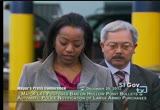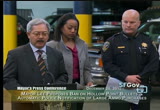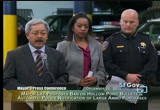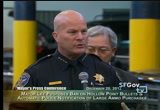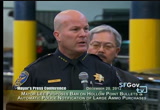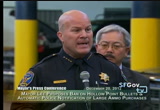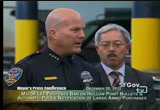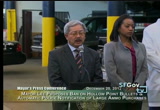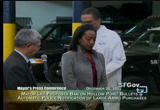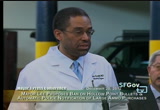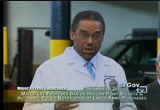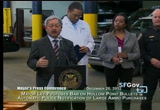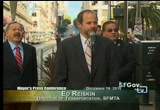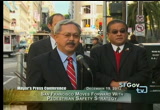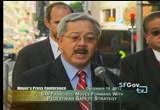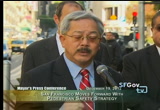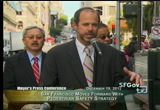tv [untitled] January 9, 2013 9:00am-9:30am PST
9:00 am
campbell, thea hollow type ammunition especially [speaker not understood] to victims because the ammunition is designed to expand and shred an individual's internal organs upon impact, making it nearly impossible for a medical professional to repair and save lives. last week i had the pleasure of joining the police department as well as our community partner the omega boys club headed by dr. joe marshall and one of the most successful gun buy back programs. we collected approximately 2 96 guns off the street, 300 we were able to get guns off of out of hands of folks. not just in the southeast neighborhood, but all across san francisco. and i think we have a collective understanding that there is a growing awareness on the part of san franciscans about the need to do more to address gun violence and to believe -- and i believe that there is a desire for us as elected officials to take
9:01 am
greater steps in implementing institutional solutions to these issues. * these weapons and this ammunition over here to my right don't belong in the hands of san francisco and online suppliers, online suppliers have an obligation to disclose to law enforcement officers information about residents buying large amounts of this lethal ammunition. i just want to say thank you for being here. i look forward to introducing this legislation. as soon as we hit the ground running in january. i appreciate your support, mr. mayor, and i look forward to continuing to working together. thank you. * >> thank you, supervisor. chief has been a great partner in not only law enforcement, with ideas of what else we could do. * chief sur i'm going to ask the chief to come up and talk about why we need to ban this ammunition, what it takes to create a system where we have reporting
9:02 am
of individuals or entities that might want to buy 500 rounds of ammunition, and why it's important that that get reported. in addition to the very successful gun buy back that supervisor cohen had mentioned, there's also other things that we are doing as well. i have instructed chief sur to make sure we introduce to the new cadets in the police academy as well as retrain every officer in our police department on school safety tactics in light of the sandy hook elementary school disaster. and he's going to do that. it's already begun. the curriculum is being designed for that. that's as important, making sure that we work in concert with our school district to make sure every campus is safe. that means school safety tactics have always been around, gets a refreshed training by everyone. chief suhr. >> thank you, mr. mayor. i want to start off by
9:03 am
reassuring everybody that what you saw play out on television, however unimaginable it was, that the heroism and the courage of the teachers at that school and the actions of the officers to respond directly in was a product of training after the columbine incident in colorado. across this country, all law enforcement agencies have been trained not to wait when there is an active shooter, but to go in immediately. and you actually saw that play out on television. and i think that for them doing that coupled with the fact that the teachers did as they were trained, and secured in place versus evacuating those kids into the hallways, had what is a horrific tragedy as far as it went, being far less than it might have been as a result of that training. as the mayor said here in san francisco, we have also trained to that standard. and as we're going through a high right now where we'll pick up a thousand police officers over the next six years, they,
9:04 am
too, will be trained to that standard. * hire we've developed a crisis management handbook that's online and the link has been sent to every school in san francisco so that they can refresh their training on secure in place. there is a time to evacuate and then there's a time to stay put, wait as it was said in the media, to wait for the good guys. so, they did that in sandy hook and it saved lives. we will do that exact same thing should that event happen at any point in san francisco, and we're going to train so that that's the case for as long into the future as we can see to keep our kids safe. i, like supervisor cohen, want to applaud the mayor's leadership on this, to identify the most lethal ammunition, and to have allow the citizens to allow the police department to maintain the database. being the first city in the country to make that ammunition illegal as you will hear later, dr. campbell from probably the best trauma ward in the country
9:05 am
will tell you what that ammunition does to people when they are hit by it. and then, again, to ask for a reporting on people that purchase as much or more as 500 rounds of ammunition so we cannot only track those people that are buying ammunition, but frequency of purchase as you can stockpile that ammunition. it is not going to be the -- any sort of suspension of the constitution. this is just smart, thoughtful community coming together with law enforcement so we know what people are doing and a simple question can be asked and if it's for target practice, that's fine as long as it's not the most lethal ammunition. the leadership in this country, you know, we've been divided for a while over small ideas and now we're coming together unfortunately after this tragedy over a big idea. and that's gun control. can't tell you how much the major city police chiefs of this country support the mayor.
9:06 am
senator feinstein, congress, state senators, and mayors like mayor lee that we're fortunate to have, on gun control. senator feinstein will re-submit the assault weapons ban which bans 100 specific assault rifles, including the weapon used in sandy hook and high-capacity magazines of 10 rounds or more. there's other things that we as major city chiefs would like to see happen, such as the banning of internet ammo sales. we'd like to see in-person transactions. the record of sales and licensing of ammo vendors, and other things i can talk to you about off line. we are doing everything we can to make san francisco a safer place and reduce violent crime. the mayor spoke of ipo, which he introduced at the very beginning of august. and for the first august in memory and maybe even on record, we suffered zero homicides in that month.
9:07 am
unfortunately one homicide in the city is too many. we've had 67 this year to date, which is up over the last couple years, record low. still the best we've had in 10 years absent those record lows. gun violence is down 4% in san francisco. largely because of community partnership. things like our gun tip line which i'll give you, 575-4444 and things like the gun buy back program. if you don't think that one of these guns or any of the other 2 96 * guns that were recovered here of the 300 guns that chief howard jordan and youth uprising were able to get over there weren't going to fall into the hands of somebody that might use them, you're betting against the odds. the shooter in newtown, connecticut, got those guns from his home, legally purchased firearms. we took 2 96 guns off the
9:08 am
street here thankful to dr. joe marshall and omega boys club. over 150 handguns, almost 150 rifles and shotguns, these are not what people keep saying aren't going to make a difference. this is absolutely making a difference. and i would say to the nra or anybody that says, hey, this isn't the problem, if it's not the problem, it will make a difference, it should make a difference banning them. let's err on the side of caution, keep the kids safe. thank you. >> let me also echo again my appreciation for commissioner dr. joe marshall because omega boys club has been a great partner. they are part of our effort to organize commutes, to intervene as early as we can, and i totally agree with the chief that these particular guns, if you look at them up front and close, you'll see they really shouldn't be in anybody's homes. they're designed to kill folks.
9:09 am
many of them military style. i think to bring home the real story here is dr. andrei campbell of our san francisco general hospital, and also on staff at ucsf. he is at the forefront of world class trauma center that we have. and if you go day to day, and certainly with the 67 homicides that we have with the numbers of bodies that were showing up and people have shown up, many of which he saved, many of which he couldn't save that were victims of bullets and violence and gun violence in our city, you know that that's another good reason as to why we need to do as much prevention as we can. dr. campbell. >> good afternoon, mayor lee, supervisor cohen, chief suhr, members of the press. my name is dr. andrei campbell and i've worked at san
9:10 am
francisco general hospital for the past 19 years as a trauma surgeon. before i came to san francisco i worked in new york. i have 24 years of experience of caring for victims in two major cities in our great country. this week all of us have watched with horror the events in newtown, connecticut, with great sadness as we learned the devastation that one person brought on that quiet community. i've seen the devastation that guns have visited on victims of crime. my heart goes out to all the victims and their families as they struggle to understand what has happened over the last week. san francisco general hospital is the only trauma center in the city and county of san francisco and in the u.s. it is, in fact, i think, the best trauma center in the united states. we stand ready 24/7 to care for any injured patient in the city and county of san francisco. we also at general hospital are caring for uninsured and underinsured people who come in after injured. we also represent -- i also represent thousands of
9:11 am
dedicated physicians, surgeons, nurses, administration and therapists who care for the hundreds of thousands of patients who come to our hospital. i have dedicated my life to providing care for injured patients in our community. it is truly a team effort to provide care for the victims of vie lertctionv crime. we rely heavily on our many trained professionals 20 help us do our work each day. after persons injured due to shooting after the scene, people go there, public firefighters and servants. the trauma surgeons, emergency physicians anesthesiologists, orthopedic surgeons, nurses, therapists and many, many others who come to help us work on the patient. and we do this for every single person who is injured. we bring all the resources there. we can to make sure we can save as many people as we can each day. the reality and sadness is we may save many, but we can't save everyone. over the years i have seen massive increase in the fire
9:12 am
power witnesses before you today. these guns are more powerful and destruction are profound. from ak-47s, other assault-style weapons, hand gun, extended clips, hollow point bullets, black talon weapons, bullets and other things like that, i've seen them and the work that -- the problems they cause each day. the larger weapons create absolute devastation in the victims. when they strike a victim, it's like a bomb going off. i struggle with all the dedicated team members to save their lives as it's real a a battle against life and death. sometimes they have overwhelming mortal wounds and i cannot save them. we save a lot, but we can't save everyone. they have massive chest, abdominal, leg, head wounds that become -- that are the consequences of these large weapons in froth of you. -- front of you. they are the victims, but their families that are also injured when or have problems after the
9:13 am
shooting. when a victim dies it leaves a hole in the family. they can't ever forget the devastated mothers, father's, sisters, brothers, that are struggling with loss. the way of a mother is unique sound as she screams, my baby is dead, my baby is dead. * wail it is a terrible sound, i wish i would have to never hear it again. part of the process of making sure these lethal weapons are off the street. if we save the patient, they have to deal with many operations, icu care, post tau matt he -- posttraumatic stress. head injuries, disfiguring operations and long-term care and many, many other serious problems. we cannot forget the physical scars, but there's also emotional scars after they are injured. at san francisco general hospital a number of gunshot wounds has declined in recent
9:14 am
years. in 2007 we cared for 381 shooting victims in our emergency department. 2011, the last year we have data on, that number is now 182 shooting victims. while this is a substantial drop, i submit to you that one is too many. these numbers represent the patients who are transported to the hospital, not the victims who died at the scene or do not come in for care. many people are killed from homicides, but suicide taking one's life with weapons is much more common in the united states. it is a silent killer since more than twice as many people die of suicide than homicide historically in the united states. there is an hep dim i can of violent crime committed with guns and is a serious public health problem that we must confront head on. * it is incidents like this past week bring these terrible crimes out in the public, but the reality is people are killed every day in this country with weapons that
9:15 am
permanently change the lives of the families that they are with. in conclusion, i would like to thank the mayor for inviting me out to stand with supervisor cohen, police chief sur, to support sensible gun control. the trauma center stands ready to care for victims. any initiative that can reduce guns in my opinion will make the streets and the cities and counties -- cities like san francisco a much safer place to live. i thank you for your time this morning. >> thank you, doctor. today we're focused on ammunition and immediate interruption in the behavior that law enforcement advises us and sees every day that leads to more violence. in the weeks and months to come, the board and the mayor's office will be introducing both more ideas and legislation and resolutions to support federal and state efforts in the same direction.
9:16 am
at the same time, we'll also be introducing through our budget support for an ongoing organizing in our community to support nonlaw enforcement efforts to reduce violence, whether it's education, social services, housing, none of that escapes us as to their link in efforts to reduce violence in our society. with that i want to thank everybody for coming today. and i would ask everyone in san francisco, if not the whole region and the state, to please join us in a national moment of silence that will occur tomorrow morning east coast time, it will be 9:30 a.m., and here in san francisco it will be 6:30 a.m. for a national moment of silence to remember all the victims in sandy hook. of course, at the same time, remember all the victims at our own locally it victims of gun violence. and before and after this
9:17 am
moment of silence we will be active doing the things we need to do to reduce violence in our city. thank you. >> okay, good morning. thank you all for coming out today. we're very happy to be here. my name is ed rifkin, i'm the other ed, director of transportation. and as the transportation director, i oversee the sfmta which is the agency that is charged with implementing the city's transit first policy. and what our goal, what the city's goal and the transit first policy is is to make sure
9:18 am
that everybody can get around san francisco, that everyone can get to where they need to go. it is an important part of making the economy of san francisco work, to making the quality of life good and better. but it's not just get around san francisco any old way. this is san francisco, and we have values that we bring to our transportation system. we want people to get around in a way that steps lightly on the environment. we want people to get around in ways that are enjoyable. and that really contribute to what makes san francisco special, such as our wonderful cable cars. but above all, we want to make sure that people can get around the city safely. it's no good to have a great transportation system if people can't get around safely. people need to not only be able to be safe, but to be able to feel safe, and nowhere is that
9:19 am
more important than when you're on foot because that is when you're arguably the most vulnerable. it's also how every trip starts and ends. and many trips in san francisco, and we want more of them in between, to be on foot as well because it's a nicer way to enjoy the city. but if we want people to be out and walking, we need them to be safe. we want them to feel safe, and that's what we're here to talk about today. and none of that will happen without great leadership. so, without further ado, happy to bring up our great leader, the mayor of the city and county, ed lee. (applause) >> thank you. thank you, david. i'm the other ed. happy holidays, everybody, and thank you for being here. we are initializing our pedestrian safety, pedestrian strategy, and we've had a task force that have included our
9:20 am
police department, our mta, our public works department, our health department, as well as advocates in the community with walk sf. and i noe elizabeth is here today, and she'll be speaking as well. * we are one of the most walkable cities in the whole country, and we encourage that. we want that to happen. and we're here today on the power promenade because it's one of the best examples that we have done in recent years where we have combined the physical elements of widening the sidewalks, of creating park lets, of encouraging people to shop and visit and do all the fun things that we do. * powell promenade we probably at this time really challenge ourselves as a city to make walking even more safe. and even though there's more people walking, there's local visitors, there's shoppers, there's international visitors coming, and they utilize our streets and the sidewalks even more.
9:21 am
we have to do more. we can't be satisfied with just what we've done before because we have the data that shows us more and more where the hot spots are all over the city. and we have also been concentrating on what makes a neighborhood more dangerous for pedestrians, what makes a neighborhood more safer. and i suggest to you tonight that -- or today that in our downtown area is probably one of the most safest areas to walk buzz we pay a lot more attention to that area. but there are a lot of other places where we haven't considered the issues of lowering the speed, as we've done around our schools with walk sf. we haven't done enough study around the data, completed the data of collision and pedestrian injuries as well as we should have to make it safer. so, our pedestrian strategy really is in draft form. we have completed it in this month, and we plan to introduce
9:22 am
it throughout the various public agencies and commissions and allow it to be publicly vented. but we do have two very solid goals, and that is by 2016, we want to reduce the number of serious or fatal pedestrian accidents by 25% in the next four years. and by 20 21, by 50%. we want to reduce that number. that's a great goal. we've always got to drive ourselves with reasonable but serious goals to reduce these pedestrian fatalities, and we know we can do it because on various streets where we've given it the kind of treatment that we've had, we've increased the amount of safety efforts. it has helped. and with mta, with our police department, with our health department, with our advocates in the community and our schools and everybody else, the other part of that strategy and that goal is to do a much more
9:23 am
serious education marketing campaign. we've got to educate everybody using our streets. so, we're choosing today in the middle of the beginning of our holiday season with everybody's attention on having great fun, having wonderful events, having serious sales that allow people to shop, this is where the consciousness has to be risen. and, so, in light of this, we picked this day and this time and this area of year to make this announcement that we have a pedestrian strategy that's going on, a serious one. we're jointly doing it with the collaboration of all the different departments. we have asked and part of the strategy will be our police department, really doing a lot more enforcement strategically in all the areas that we need to, with not only stops, not only enforcement and ticketing, but a serious effort to remind people that these are going to
9:24 am
be spots where we are going to pay a lot more attention. we have the mta, with ed's leadership and his staff, parking and traffic and others, working to do some of the physical improvements that remind everybody that we emphasize pedestrian use, more walking in the city, but also the safetiness of it by safety areas. with our school districts, obviously working with walk sf and the wonderful leadership in our schools and in our communities, educating everybody and helping us create the very good marketing education campaign that we need to remind everybody to do so. and then our health department, of course. they carry the very serious burden of giving us statistics, of what it is on the collision as well as injury rates and reminding us that a healthier city could be one that we reduce the fatalities that
9:25 am
happen with pedestrians. so, this is part of that whole strategy. we will consider areas of the city that we will have to lower the speed limit and enforce it and educate people around it, as well as more serious and higher and deeper ways of educating the public and the drivers as well as pedestrians themselves. this is all part of i think a good strategy, one that i'm very willing to lead and make sure every department and all of the store fronts along here, as well as people who drive cars in and out of the city, understand we're going to focus on all the hot spots and really lessen that inequality we know today, neighborhoods, people literally fear walking on our streets because there is not a presence that we've had, similar to what we've had downtown. we've had a great presence with all the collaboration going on. we really mean to lessen that disparity, that inequality that happens, and make sure
9:26 am
everybody neighborhood is safe. that will lead to more fun, more shopping, and more paying attention to all of our commercial neighborhoods across the city. thank you. >> thank you, mr. mayor. it really is the leadership that mayor lee is bringing to this. it's been a hallmark of his administration to bring the city family together to work with the advocates in the community to get things done. i think this pedestrian strategy is a manifestation that epitomizes what the mayor is doing to bring folks together to make san francisco a better place. i want to thank him for his leadership. the leadership on the ground, i think a lot of it is coming from the mta board. but the ground that i'm literally standing on here is ground that used to be here for vehicles, and now it's here for people, for people to walk, to
9:27 am
sit, to enjoy. making those decisions are sometimes difficult. they're sometimes controversial. there are trade-offs involved. but we have a very strong board of directors at the mta that has been making these decisions to repurpose, to rethink our rights-of-way, to reorient them back towards pedestrians, to make it safer for pedestrians, to narrow streets so that the crossing distances are shorter, and to really focus on the safety aspects of improving our public rights-of-way. so, i'm happy to have one of my boss as a member of the mta board of directors, jerry lee. >> thank you, thank you. i know that when i speak on behalf of the board of directors, we're really encouraged of the efforts that we're involved with in terms of being at the starting point of square one. this is a critical moment for our city in terms of the efforts of making the streets more attractive and safer for
9:28 am
pedestrians. i also want to acknowledge the work of the sustainable street division who has helped in getting these speeds at the schools reduced. this strategy will help bolster their efforts in making the city streets a lot safer for pedestrians to walk in. thank you very much. >> thank you, director lee. one of our, one of our strong partnerships is with the police department. we kind of share responsibility for managing the public right-of-way and enforcement as you heard from mayor is absolutely a part of the strategy. so, it's a very important partnership for us and very glad to have the police department so ably represented here, but more importantly, on the task force and working with us every day. so, very happy to have one of the great leaders of the police department, deputy chief denise
9:29 am
chef. >> it's a very tall man. good morning, i'm denise smith and i don't know how to work microphones. thank you. the men and women of san francisco police department are absolutely commit today working with our partners to make the walking, cycling and motoring public safer in our city. we commit to it every day, and based on information that mta has provide and had that we have from our collision data, we've launched a program called focus on the five. and for each of district stations we've provided them their five intersections or areas where they have the highest incidents for pedestrians and motorists come in contact. and we are committed to reducing those numbers. * we've got to bring these incidents down. we want the public to be able to enjoy this beautiful city. and, so, what each of the district station captains have been tasked with is developing targeted enforcement and education for their five areas of highest incidents.
89 Views
IN COLLECTIONS
SFGTV: San Francisco Government Television Television Archive
Television Archive  Television Archive News Search Service
Television Archive News Search Service 
Uploaded by TV Archive on

 Live Music Archive
Live Music Archive Librivox Free Audio
Librivox Free Audio Metropolitan Museum
Metropolitan Museum Cleveland Museum of Art
Cleveland Museum of Art Internet Arcade
Internet Arcade Console Living Room
Console Living Room Books to Borrow
Books to Borrow Open Library
Open Library TV News
TV News Understanding 9/11
Understanding 9/11